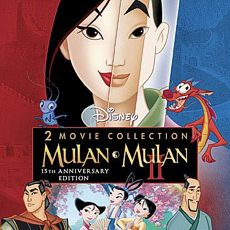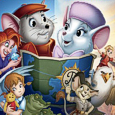Walt Disney Productions (July 10 1981), Walt Disney Home Entertainment (August 9 2011), 3 discs set comprising one Blu-ray and two DVDs, 83 and 69 mins plus supplements, 1080p high-definition 1.66:1 and 1.78:1 widescreen, DTS 5.1 Master Audio-HD, Rated G, Retail: $39.99
Storyboard:
Disney’s overlooked 1981 animated feature about two animals that become friends even when they didn’t know they were suppose to be enemies is given new life in high definition, with a less than effectively realized video mid-quel bundled in for good measure.
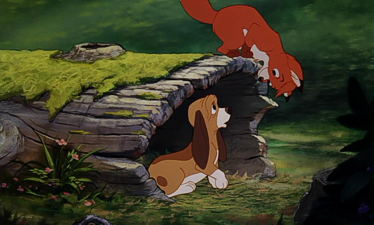
The Sweatbox Review:
There are a number of movies, live-action as well as animated, that emerged from the Disney Studio between Walt passing away and the entrance of the Eisner/Katzenberg regeneration years, that often get the short-thrift treatment when dealing in terms of box-office or creativity. While, certainly, one must question the lightness of some of the college comedies that struggled to compete with whatever else was coming out of Hollywood during the 1970s, there are also a number of true gems in the line-up.
On the animated side, Disney’s output fared better, from genuine supporters of the sometimes episodic The AristoCats and Robin Hood, to generally well received classics such as 1977’s double whammy of The Many Adventures Of Winnie The Pooh compendium and The Rescuers, a massive commercial hit that set the animation unit back on track and, until only recently, spawned the department’s only animated feature sequel.
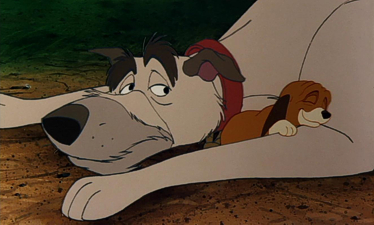
The Rescuers had proven to be something of a hand-over film from the old guard to the next generation of Disney artists, with many of the remaining Nine Old Men retiring through the production, but it was the Studio’s next film, a simple tale of a fox and a hound that became friends, where the new artists were given a chance to show what they could really do. At least, that was the original intention, before Don Bluth, frustrated at what he perceived as a lack of quality control at Disney’s during his tenure directing The Small One featurette and animation for Pete’s Dragon, left to establish his own studio with a group of likewise disgruntled Disney animators.
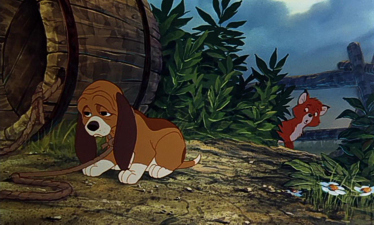
This event, coming half-way through The Fox And The Hound’s development, disrupted the animation department enough that the film – and its subsequent release The Black Cauldron – were delayed while the likes of Woolie Reitherman stayed on to shepherd a trio of younger directors. As such, The Fox And The Hound became a film of two halves in more ways than one, being a sometimes naturalistic animal story while competing with itself to include some old time Disney heart. The coming of age storyline doesn’t help the feeling that it can often feel disjointed, with the film opening with our two protagonists as young cub and pup, respectively, and moving Bambi-like forward to showing them as adults later on.
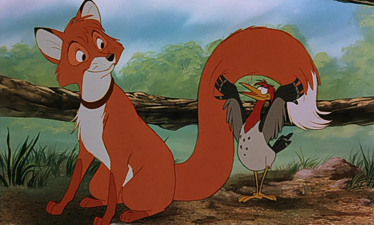
But it’s that juxtaposition that also makes The Fox And The Hound really work as a solid Disney film. Yes, there are the supporting comedy characters – in this case Paul Winchell as one half of a feathered double act out to catch a sneaky caterpillar – that might feel a little old hat, but I don’t remember thinking that when I first saw the film theatrically as a young child in 1981 and I can still appreciate the shtick now, placing the film in context. It’s what’s come afterwards that has made The Fox And The Hound perhaps feel “dated”, but it’s actually a very good film of its time. In fact, if there is anything the film does fault on, it’s the feeling that the Studio isn’t attempting anything particularly new, despite the good intentions.
While not as sombre as Bambi, The Fox And The Hound inhabits that same sphere of naturalistic animal adventures Disney became famous for with the True Life Adventures. Indeed, I often wonder if the forest seen in the second half of the film is the same “location” as the one in which Bambi lost his Mother…the visual similarities and overall tonal quality are very much the same (the film ends with a final shot very reminiscent of Bambi and Copper even fools around on ice), even if The Fox And The Hound isn’t as lyrical or artistically compelling as the earlier film.

It shares with it, too, the passing of time between its first and second halves, starting with the discovery of a new addition to the world – a baby fox cub – and the immediate death, very Bambi-like, of its parent, during a tense and unexpectedly bleak opening to a Disney movie. Helped by a kindly owl (more shades of Bambi), voiced by Pearl Bailey, the cub is revealed to a kindly woman who promises to raise him, and calls him Tod. On the other side of the forest, young pup Copper has been bought as a companion – and eventual replacement – for a hunter’s tracking hound, and very soon afterwards these two creatures, raised not in the wild but by human folk, run into each other.
Without their raw, naturalistic instinct intact, an initial curiosity that cannot be pinpointed leads to a friendship that they don’t comprehend is usually forbidden by nature. These early scenes are extremely charming, and nicely drawn, with some wonderfully authentic performances from child actors Keith Mitchell and Corey Feldman – yes, that Corey Feldman – that sound authentic and not precocious at all. The use of named actors doesn’t stop with the kids, either: while many people would put money down on knowing legendary Hollywood screen star Mickey Rooney must have featured in a Disney movie at some point, a surprising amount of people wouldn’t have a clue as to which movie it was!
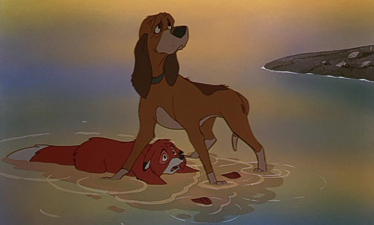
More visibly memorable in the Studio’s live-action/animation fantasy Pete’s Dragon, it’s when Tod and Copper grow up that the film shifts tone and makes use of Rooney’s vocals, bringing a soft and empathic dynamic to the now adult fox that also clearly retains the youngster at heart. Matching him is another Hollywood name, then coming off the back of a star turn as the king of rock and roll in Elvis: The Movie and a career defining role in Escape From New York after years playing in college comedies, ironically under contract to Disney’s: Kurt Russell.
Although it can be argued that Russell by this time wasn’t just another Studio contract player, some of the other voices do fall into that trap, and it’s with the casting of Paul Winchell, John Fielder, Pat Buttram and Sandy Duncan that perhaps The Fox And The Hound retains the “old” of Disney’s old-school and leads to its antiquated reputation. Yes, they’re the same voices we’ve heard in countless other Disney films, and while some of their shtick can feel unfashionable now, it was still just about fresh back in the early 1980s and only enforces the feeling of the new picking up from where the old left off: without these touches, the film might feel overbearingly sombre.
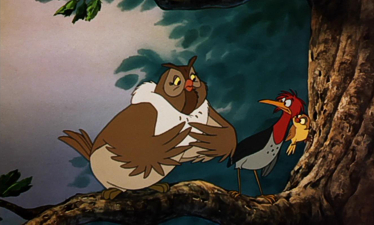
Indeed, The Fox And The Hound was undoubtedly a reaction to not only the cutesy nature of Disney’s then-recent films, but also the changing attitudes of movie audiences. Hollywood at the time was in the midst of serious-minded and topical films, and mainstream animation itself had been stretched in different directions following Ralph Bakshi’s avant-garde work and such alternate fare as Watership Down. While much of that work doesn’t really stand up to today’s viewing, The Fox And The Hound genuinely does, with a much more mature storyline that it generally receives credit for, and good vocal performances.
Apart from the excellent Rooney and Russell, popular singer Pearl Bailey (then a real catch for the Studio) adds her warmth as friendly owl Big Mamma, with Willy Wonka And The Chocolate Factory’s grandpa Joe Albertson an actual effective presence as the hunter out to get Tod, not all theatrical villainous intent, but just by playing him as a frustrated human being. Also on the soundtrack side of things, long-time Studio composer Buddy Baker’s score may not always hit all the right notes, but more often than not his live-action background actually provides an extra nuance to this animated picture, with some truly stirring elements in the music that have a real thriller aspect to them.
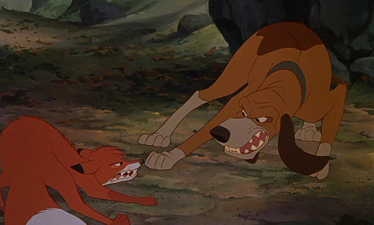
Bailey is also responsible for the film’s best known song. The Fox And The Hound is (rightly) not very well known for its songs, but although they’re not all memorable, they do precede the later “source music” idea in Disney films, with some moments being internal monologues that, while they may not all work, offer up a different approach that keeps the film feeling familiar but new in design. However, Bailey’s The Best Of Friends became something of a hit and certainly captures the film’s essence, being its signature tune.
In the animation department, it’s truly a mix of old and new, too. Frank Thomas and Ollie Johnston serve as Directing Animators alongside such newcomers as Glen Keane and Randy Cartwright, while the artists themselves strive to retain the lush, full animation of Disney’s heyday, with color Xerography that moves away from the black, sketchy lines of One Hundred And One Dalmatians and really helps to reach towards the clear ambition of creating a work that could stand alongside Bambi (the next generation would have another chance with those aspirations when The Lion King came along almost 15 years later).
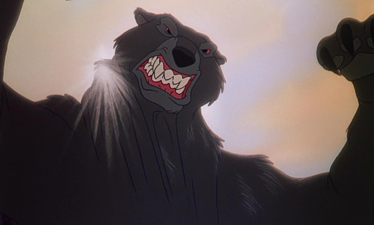
Keane, famously in particular, shines most with his virtuoso bear attack and fight sequence, set thrillingly towards the end of the film and providing a powerhouse climax that brings back the film’s realities-of-nature tone. Featuring his trademark bulky weight and broad shoulders, the bear is a ferociously dangerous animal – realistically designed much more so than the cuddly grizzlies of Brother Bear – and a real threat to hunter Amos Slade when he is caught in one of his own traps. Tod’s leaping to distract the animal from Slade is one of Disney’s most satisfying endings, and the following scenes where Copper then protects his friend in the aftermath is expertly done in a very hushed, calm way that sets out the new artists’ dramatic intentions for the films that would follow.
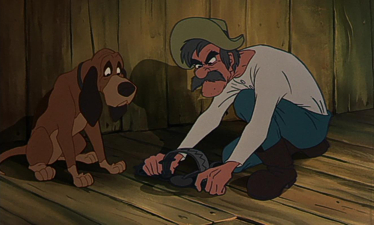
With this newly restored print of The Fox And The Hound, I would hope that it can regain some serious recognition for the very fine and overlooked film that it is, rather than being seen as one of Disney’s also-rans or cute critter features, which it is genuinely so much more than. Often bundled in with the lesser features released by the Studio, the child-friendly marketing and emphasis on the younger aged characters hasn’t helped the film date as well as Bambi has, when perhaps the emphasis should have been on their older, more authentically rounded incarnations. If you decide to revisit The Fox And The Hound, and this is definitely a recommendation, I think you may be more surprised than you might remember.

Is This Thing Loaded?
Arriving as a three-disc 30th Anniversary Edition, the most bizarre aspect is how the bonus features have been sliced up across the platters. The Blu-ray Disc is where the belated full-length video sequel, The Fox And The Hound II can be found, which I have included here as the extra that it feels like, rather than as a true companion to the original film. As with the eventual Bambi II, the further adventures of Tod and Copper aren’t really anything of the sort, being a mid-quel “adventure” inserted between the passing of time from them growing from childhood to maturity.
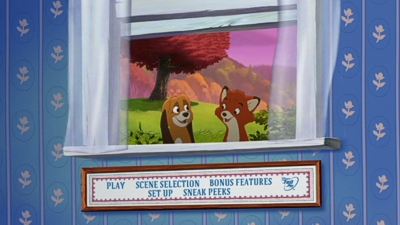
This choice is perfectly understandable from a marketing point of view, since the younger incarnations are infinitely more cuddly, child-friendly and easier to sell as typically safe cute Disney critter fare, but it leads to a frustrating trapping of possibilities as far as creating a story being anywhere near substantial goes, as we know where the characters must end up in order to revert to the original’s plot. Taken for what it is, I suppose there’s a little bit of fun to be had and it’s not exactly like they’re messing with one of Walt’s original classics, but even so the storyline is weak and actually bypasses the two main characters for much of the time. My colleague Randall Cyrenne was less harsh about The Fox And The Hound II in his review of the original DVD release, but I’m afraid I just didn’t see the worth in this outing.
At least visually in other DTVs, such as Scamp’s Adventure, Bambi II or Return To Neverland, there seemed to be a careful attention paid to trying to match the cartooning and atmospherics of the original films they were attempting to follow up, but the 1981’s somewhat rough approach has here been replaced by an all-too slick computer enhanced 2006 look that feels at odds with the original characters and their lazily designed new additions (the Patrick Swayze and Reba McEntire-voiced pooches continually reminding me of All Dogs Go To Heaven’s Charlie Barkin and Oliver And Company’s Georgette, and a talent scout clearly related to Home On The Range’s Alameda Slim, for starters).
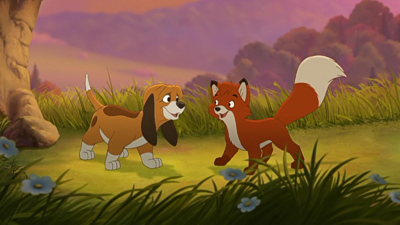
Colors are not the sometimes harsh and lyrically realistic approach favored by Bambi and the original film, but lighter, fluffier and brighter tints that are over-shaded as to become gaudy. Artistically, the characters sport very little personality – something of a regular occurrence with the DTVs – and more times than not Tod kept reminding me of The AristoCats’ Toulouse rather than the fox of the original film. I was surprised to see none other than Eric and Susan Goldberg’s names in the credits – presumably during the drought of quality feature animation assignments – and can only assume that their hands are all over the Singin’ Strays’ human manager’s animation, since he’s the best thing in the picture.
While The Fox And The Hound II doesn’t quite reach the nadir that some of the Disney direct-to-video titles would do, it’s certainly one of the very bargain basement entries in the line. When The Rescuers or The Great Mouse Detective surely had more adventures to be had, it’s the instantly creatively “mid-quels” that helped nail the coffin shut on these types of DTVs, as well as leading to the abandonment of further titles which, as actual follow-up stories, sounded quite fun: Dumbo and friends being lost in the big city, or the AristoCats’ jaunt to Europe might have been worthwhile diversions if such films as The Fox And The Hound II hadn’t swamped the market with mediocre quality.
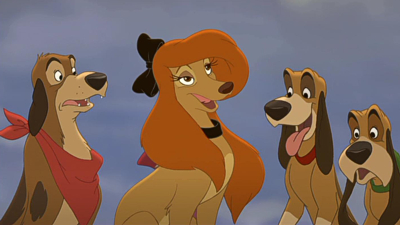
As far as the Blu-ray goes, there is one other lone bonus feature, which attempts to tie the two films together by way of illustrating a series of Unlikely Friends in a seven minute featurette that also contains factual clips and moments from other odd Disney pair-ups to show how differing animals can get along. It’s quite breezy, but that’s it for anything feature film related, meaning that it’s the two DVD discs that actually get the true bonus features to themselves. Why for why they couldn’t simply load this stuff onto the BD as well (both films take up just 42gb of space on a 50gb disc), even in standard definition, is a strange choice, meaning that you’ll need to keep your DVDs as safe as the BD disc in order to enjoy the extras.
What there is of it isn’t too much, but the Passing The Baton: The Making Of The Fox And The Hound featurette (6:40) is welcome for what it is. Calling it a “making of” is much grander than it deserves, however, since this is just really a grouping of interviews from the previous DVD release recycled, where such current names as Randy Cartwright, Glen Keane, John Musker and Ron Clements discuss how they strove to continue the work of the classic Disney animators. There isn’t too much on the actual making of the film, or naturally anything about the upheaval created by Bluth’s exit and the general downbeat mood in the animation department at that point – which explains a lot about the film’s melancholy attitude – nor anything on then-animator Tim Burton’s contributions on Vixey, but at least we get a glimpse at some production art even if its not really acceptable that we don’t get a dedicated stills gallery.
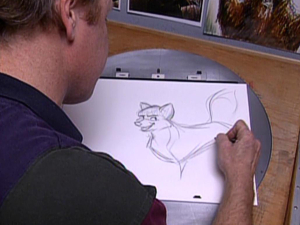
The rest of the supplements don’t add up to much either: a The Best Of Friends Sing-Along looks terrible in pre-restored video quality, while on the sequel’s DVD, the extras are limited to The Fox And The Hound II: Making Of The Music featurette (10:05), focusing on the blue-grass contributions of the recording artists, and a You Know I Will music video performed by Lucas Grabeel. The usual Sneak Peeks across the discs include The Lion King, Spooky Buddies, Dumbo, Tinker Bell And The Pixie Hollow Games/Mysterious Winter Woods, DisneyJunior, Mars Needs Moms, Bambi II and Disney’s Movie Rewards program.
Although the best of the supplements is the Passing The Baton featurette, as a piece of fluff it’s nowhere near in depth enough, and much, much better would have been to include the Hayley Mills hosted TV special Disney Animation: The Illusion Of Life, which went behind the scenes on over 50 years of the Studio’s films to show us how the technique had come on, featuring specific footage of The Fox And The Hound in production, including interviews with Glen Keane and recording sessions with Pearl Bailey performing The Best Of Friends while being referenced by the animators. Some of that footage is seen in the featurette, but honestly a few seconds of behind the scenes doesn’t cut it.
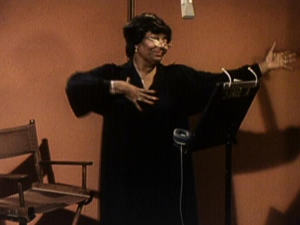
Also appropriate would have been the nostalgic featurette Once Upon A Mouse, which played with The Fox And The Hound in its original theatrical run. A half-hour, and highly entertaining, assortment of specially compiled clips that celebrated the release of the Studio’s then-newest feature, it’s a now rarely seen retrospective that any Disney fan would appreciate. If ever there was a chance for Disney to include these wonderful programs in an appropriate home video release and not only really surprise and amaze fans but also turn a title into a must-have release, this was it, but the opportunity has been sadly overlooked and unfortunately passed.
Case Study:
Disney’s now standard Blu-ray packaging is in full force here, with a blu-rimmed slipcover focusing most emphasis on the 30th anniversary original film, although I’m not sure I’m liking the inside that stacks both DVD discs on top of each other. The back cover blurb is stretching, too, saying very little about the films themselves and just repeating the mantra that you get two films in one, on Blu-ray, in high-definition, on three discs, with a DVD of each film, and a Blu-ray, featuring two films…well, you get the idea.
Ink And Paint:
For years, the original aspect ratio of The Fox And The Hound has been under debate, and for good reason: Disney having pulled their evasive trick of advising that the film, in previous home video releases, was being presented in its original negative or aspect ratio of 1.33:1. While not strictly true (films are actually shot to a 1.37 aspect, narrowly and marginally cropped for 1.33 showings on 4:3 displays), this did indicate that The Fox And The Hound’s intended ratio was 1.33, strange for the Studio’s films which, from the 1960s had been animated to that ratio but cropped to widescreen in theaters. With this release, the record can be set straight: The Fox And The Hound was animated to a 1.37:1 negative, which was cropped to 1.33 for television and likely to 1.85:1 in theaters.
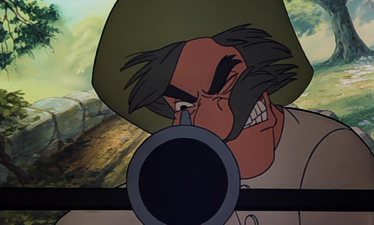
Providing a more than suitable middle ground, this new 1.66:1 aspect presentation retains the full width of the 1.37 frame while only mildly cropping the height (certainly less so than in theaters) and formats the picture as per all of the Studio’s post-1950s widescreen features should be screened. Even more importantly, this new digital restoration is absolutely not a load of baloney, and while not as pristine as the bigger archival titles’ clean-ups, my jaw often dropped when I saw what good treatment The Fox And The Hound – especially given its reputation – has been given here. It’s certainly film derived, but looks like a new film, feeling fresher and more layered than its 2006 clinical follow-up.
Scratch Tracks:
Although Buddy Baker’s score can often sound thin in the high-end strings, I was often surprised at how full The Fox And The Hound’s audio sounded, coming from the early days of Dolby Stereo and long before the advent of digital soundtracks such as the DTS Master Audio-HD presentation found here. Clarity is exceptional, with a warmth to the vocal performances especially that I haven’t been able to pick out before, and a mix that manages to represent the timbre of the original tracks without resorting to fake spacing or speaker placement. The second film, from 2006, naturally has a richer, fuller sound, as one would expect from a film created in DTS to start with, but with that comes a more aggressive mix for a film that doesn’t really match the intentions of the original. English, French and Spanish 5.1 dubs and subs are bundled in for both films, while the sequel’s original DVD DTS track has been dropped from that format here in favor of Dolby Digital for both films.
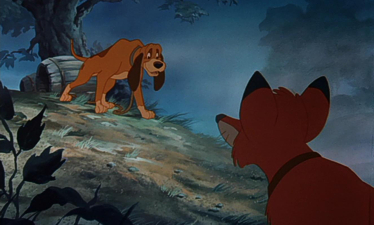
Final Cut:
Not the first animated classic from Disney’s vault that comes to mind for the full Blu-ray restoration treatment, the announcement of The Fox And The Hound on the format was understandably met with something of a surprise. My hope is that this shows Disney has a renewed respect for even the so-called secondary animated titles in its library and that we may see more such films in the future, especially given this kind of almost pristine treatment. While the film isn’t premium-grade Disney, and comparisons to Bambi would be tough for any film to aspire to, The Fox And The Hound is nevertheless more heavyweight than its reputation suggests, although this disc doesn’t support the film as it might in the supplemental department. It’s kind of neat to have the video sequels relegated to extra content, which is where the majority of them belong, but the omission of Once Upon A Mouse or – especially – the Illusion Of Life documentary is a particular shame on this title specifically.
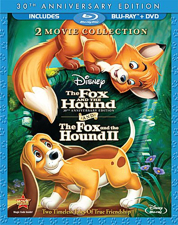 | ||
 |









